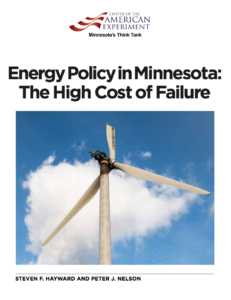Minnesotans’ Electric Rates: Gone With the Wind
 Minnesota has been on the cutting edge of mandating renewable energy quotas for the past decade. But to what end? Center of the American Experiment answered that question in our recently released report, Energy Policy in Minnesota: The High Cost of Failure.
Minnesota has been on the cutting edge of mandating renewable energy quotas for the past decade. But to what end? Center of the American Experiment answered that question in our recently released report, Energy Policy in Minnesota: The High Cost of Failure.
You can download and read the report here. Or you can get the Cliff Notes version in an op-ed in Thursday’s Star Tribune by the report’s co-author Stephen Hayward. Here’s the gist of Hayward’s overview.
Minnesota has met its political mandate of supplying 15 percent of electricity from renewable sources, but the effects of this target are disappointing and worrisome for the future.
First, Minnesota’s notable electricity cost advantage has disappeared. For most of the last 25 years, Minnesota’s electricity prices were about 20 percent below the national average. But over the last five years — when renewable capacity was expanded at a fast pace — Minnesota’s cost advantage has rapidly disappeared, and in March for the very first time Minnesota’s electricity prices rose above the national average.
This has happened at a time when electricity use has been flat, so the price pressure has not come from increased demand. If Minnesota’s historic price advantage had stayed within its historic range, Minnesota consumers would have saved $4 billion.
The higher electric bills might be worth it for global warming alarmists. But Minnesota falls short on that metric, as well.
Second, the real embarrassment is that renewable energy is not achieving significant reductions in carbon dioxide emissions. Between 2005 and 2014, Minnesota’s CO2 emissions fell 6.6 percent (and much of this reduction was achieved by greater use of natural gas, not wind), while the nation as a whole reduced CO2 emissions by 9.3 percent. In fact, over the last two years, greenhouse gas emissions from electricity in Minnesota have risen, even as more wind power was installed. This is not unusual. Recently the New York Times reported that although Germany has spent $200 billion subsidizing renewable energy over the last 20 years, its greenhouse gas emissions are the same as a decade ago, and they have also started rising again over the last two years. Oh, and German electricity rates have doubled during that time, despite the heavy subsidies.
You can read Hayward’s complete op-ed on the Star Tribune website.